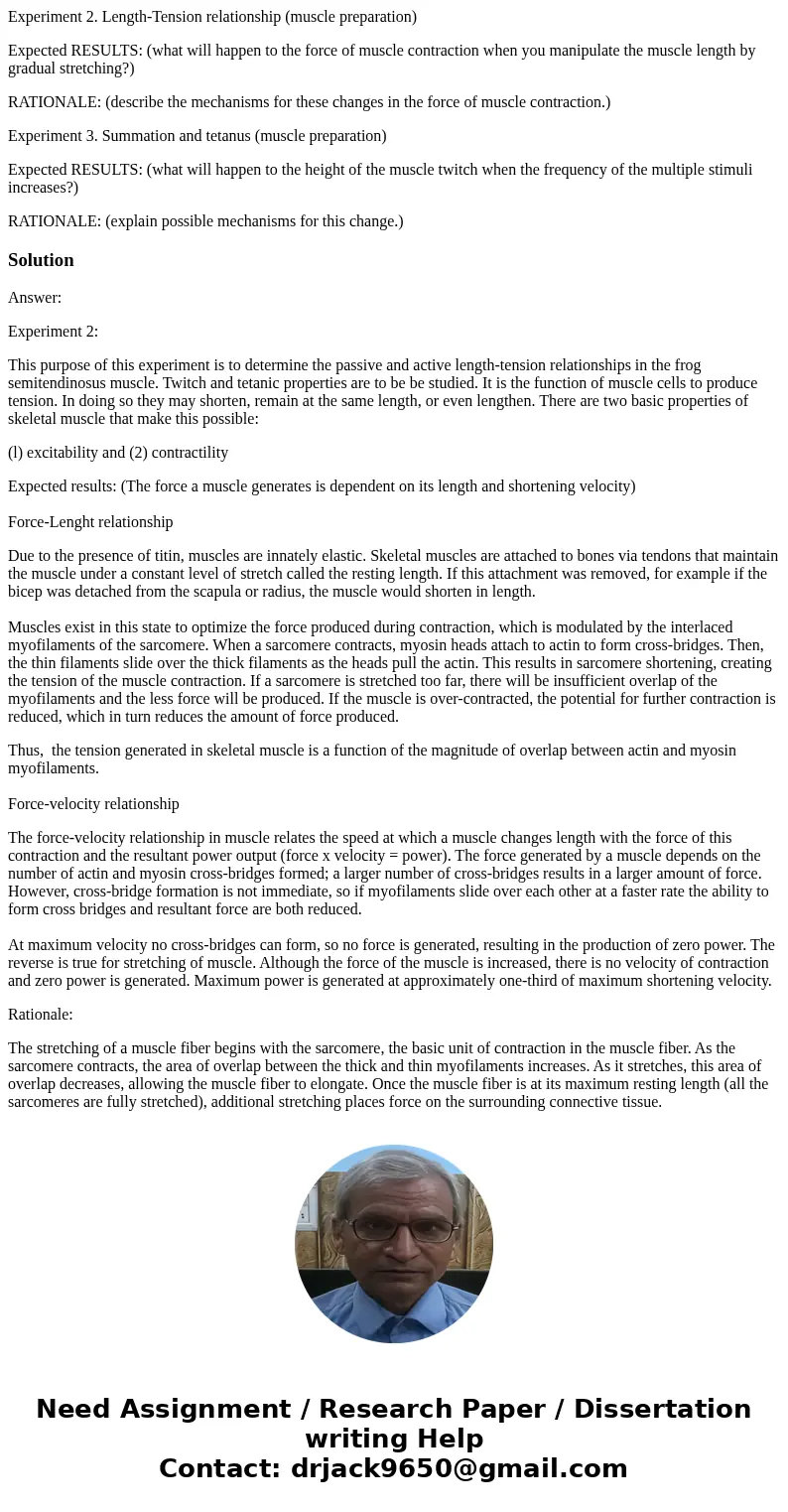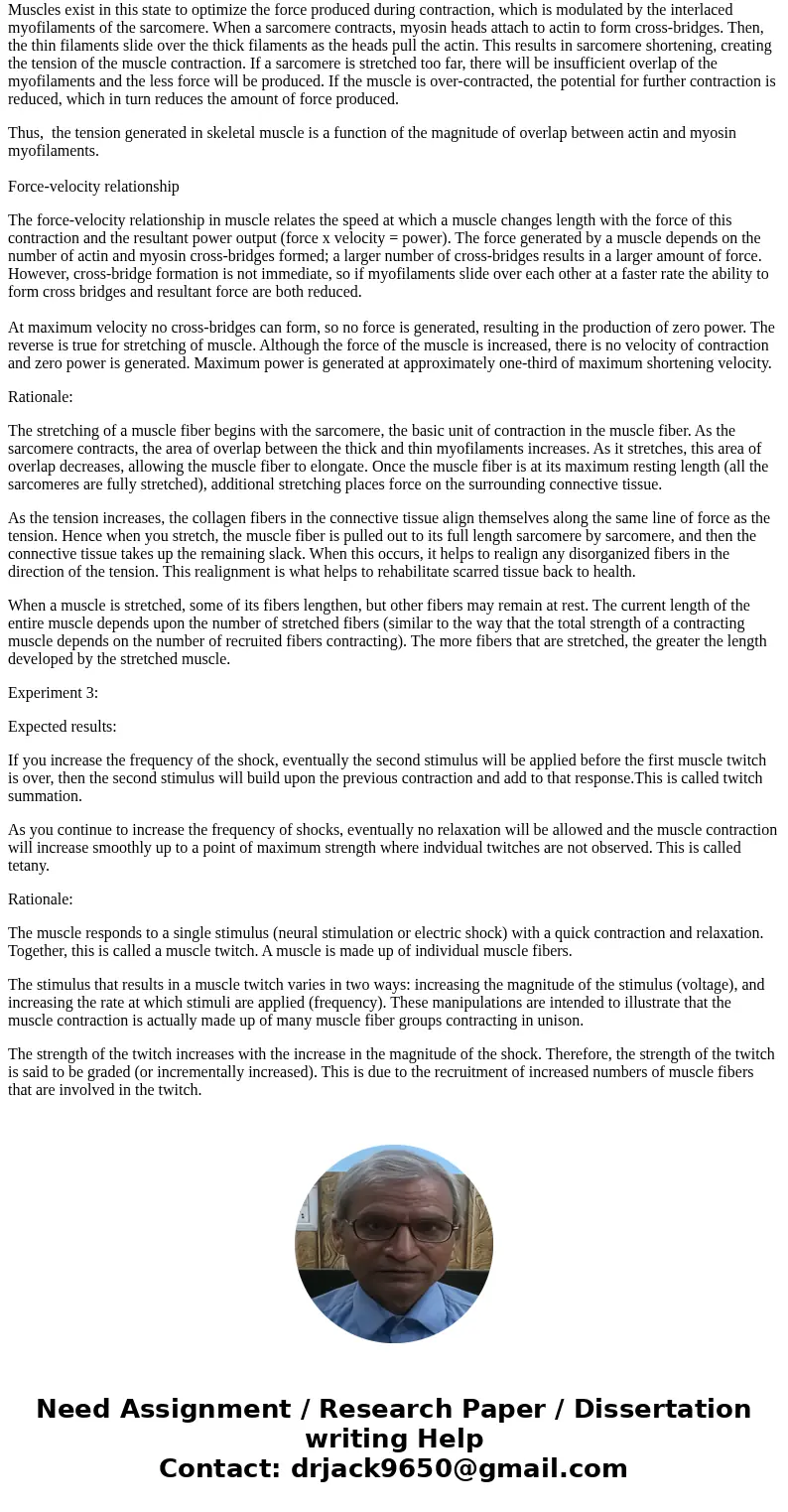Experiment 2 LengthTension relationship muscle preparation E
Experiment 2. Length-Tension relationship (muscle preparation)
Expected RESULTS: (what will happen to the force of muscle contraction when you manipulate the muscle length by gradual stretching?)
RATIONALE: (describe the mechanisms for these changes in the force of muscle contraction.)
Experiment 3. Summation and tetanus (muscle preparation)
Expected RESULTS: (what will happen to the height of the muscle twitch when the frequency of the multiple stimuli increases?)
RATIONALE: (explain possible mechanisms for this change.)
Solution
Answer:
Experiment 2:
This purpose of this experiment is to determine the passive and active length-tension relationships in the frog semitendinosus muscle. Twitch and tetanic properties are to be be studied. It is the function of muscle cells to produce tension. In doing so they may shorten, remain at the same length, or even lengthen. There are two basic properties of skeletal muscle that make this possible:
(l) excitability and (2) contractility
Expected results: (The force a muscle generates is dependent on its length and shortening velocity)
Force-Lenght relationship
Due to the presence of titin, muscles are innately elastic. Skeletal muscles are attached to bones via tendons that maintain the muscle under a constant level of stretch called the resting length. If this attachment was removed, for example if the bicep was detached from the scapula or radius, the muscle would shorten in length.
Muscles exist in this state to optimize the force produced during contraction, which is modulated by the interlaced myofilaments of the sarcomere. When a sarcomere contracts, myosin heads attach to actin to form cross-bridges. Then, the thin filaments slide over the thick filaments as the heads pull the actin. This results in sarcomere shortening, creating the tension of the muscle contraction. If a sarcomere is stretched too far, there will be insufficient overlap of the myofilaments and the less force will be produced. If the muscle is over-contracted, the potential for further contraction is reduced, which in turn reduces the amount of force produced.
Thus, the tension generated in skeletal muscle is a function of the magnitude of overlap between actin and myosin myofilaments.
Force-velocity relationship
The force-velocity relationship in muscle relates the speed at which a muscle changes length with the force of this contraction and the resultant power output (force x velocity = power). The force generated by a muscle depends on the number of actin and myosin cross-bridges formed; a larger number of cross-bridges results in a larger amount of force. However, cross-bridge formation is not immediate, so if myofilaments slide over each other at a faster rate the ability to form cross bridges and resultant force are both reduced.
At maximum velocity no cross-bridges can form, so no force is generated, resulting in the production of zero power. The reverse is true for stretching of muscle. Although the force of the muscle is increased, there is no velocity of contraction and zero power is generated. Maximum power is generated at approximately one-third of maximum shortening velocity.
Rationale:
The stretching of a muscle fiber begins with the sarcomere, the basic unit of contraction in the muscle fiber. As the sarcomere contracts, the area of overlap between the thick and thin myofilaments increases. As it stretches, this area of overlap decreases, allowing the muscle fiber to elongate. Once the muscle fiber is at its maximum resting length (all the sarcomeres are fully stretched), additional stretching places force on the surrounding connective tissue.
As the tension increases, the collagen fibers in the connective tissue align themselves along the same line of force as the tension. Hence when you stretch, the muscle fiber is pulled out to its full length sarcomere by sarcomere, and then the connective tissue takes up the remaining slack. When this occurs, it helps to realign any disorganized fibers in the direction of the tension. This realignment is what helps to rehabilitate scarred tissue back to health.
When a muscle is stretched, some of its fibers lengthen, but other fibers may remain at rest. The current length of the entire muscle depends upon the number of stretched fibers (similar to the way that the total strength of a contracting muscle depends on the number of recruited fibers contracting). The more fibers that are stretched, the greater the length developed by the stretched muscle.
Experiment 3:
Expected results:
If you increase the frequency of the shock, eventually the second stimulus will be applied before the first muscle twitch is over, then the second stimulus will build upon the previous contraction and add to that response.This is called twitch summation.
As you continue to increase the frequency of shocks, eventually no relaxation will be allowed and the muscle contraction will increase smoothly up to a point of maximum strength where indvidual twitches are not observed. This is called tetany.
Rationale:
The muscle responds to a single stimulus (neural stimulation or electric shock) with a quick contraction and relaxation. Together, this is called a muscle twitch. A muscle is made up of individual muscle fibers.
The stimulus that results in a muscle twitch varies in two ways: increasing the magnitude of the stimulus (voltage), and increasing the rate at which stimuli are applied (frequency). These manipulations are intended to illustrate that the muscle contraction is actually made up of many muscle fiber groups contracting in unison.
The strength of the twitch increases with the increase in the magnitude of the shock. Therefore, the strength of the twitch is said to be graded (or incrementally increased). This is due to the recruitment of increased numbers of muscle fibers that are involved in the twitch.


 Homework Sourse
Homework Sourse